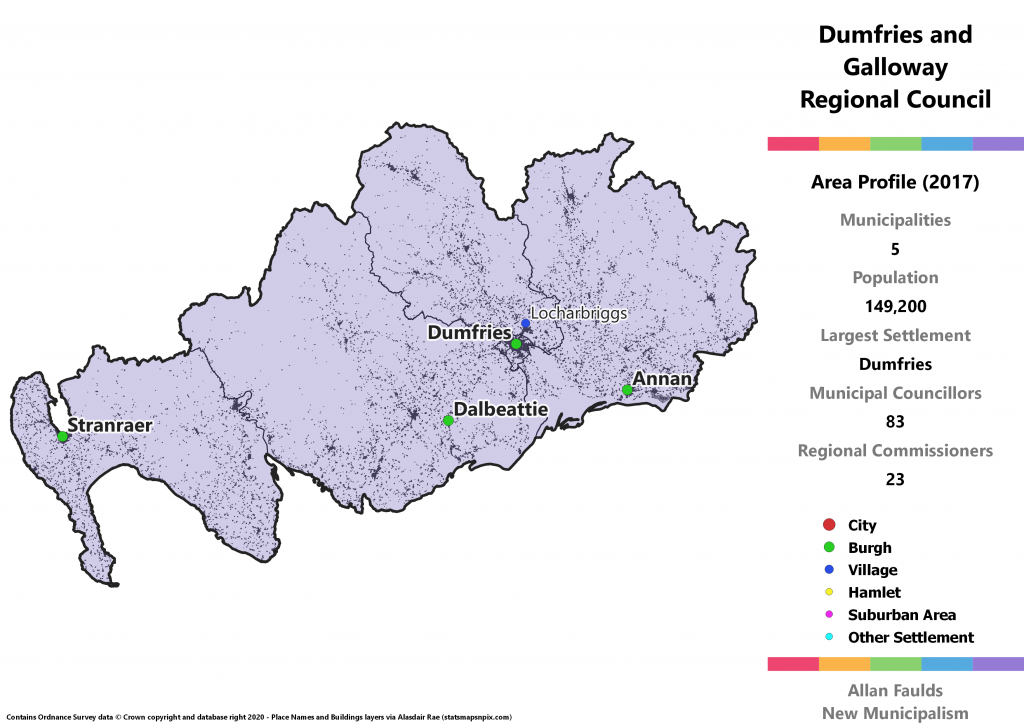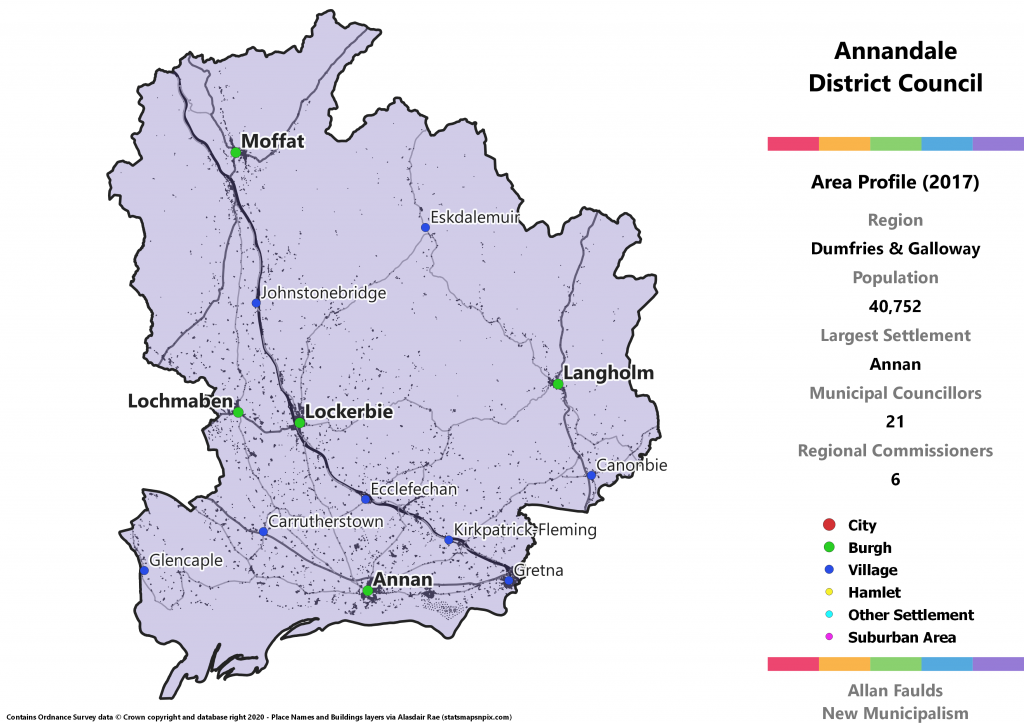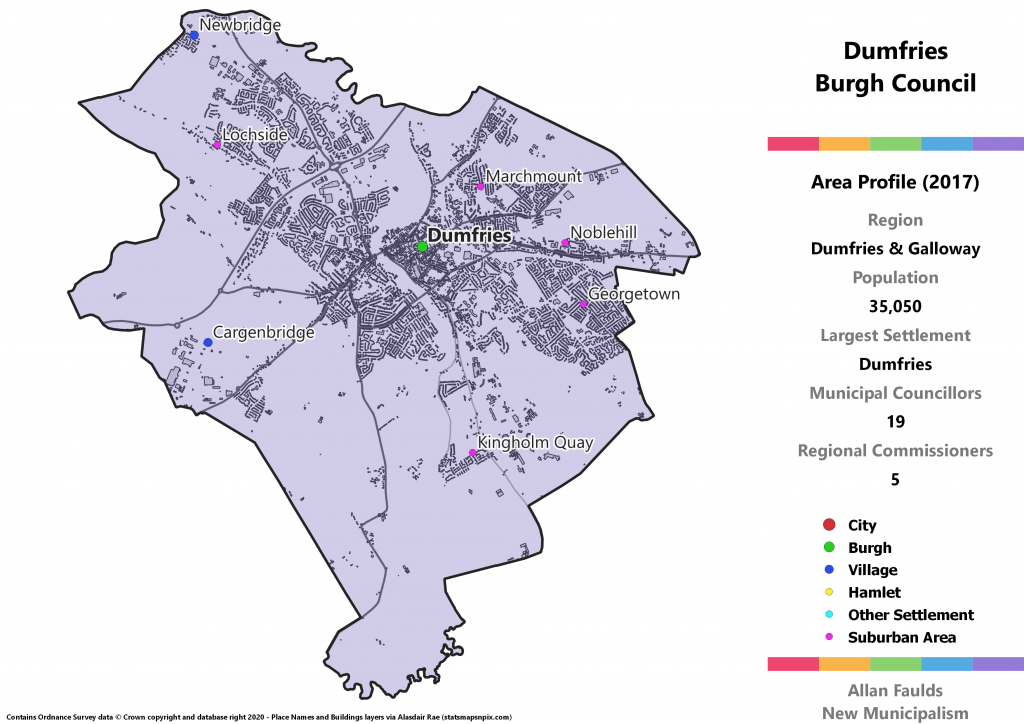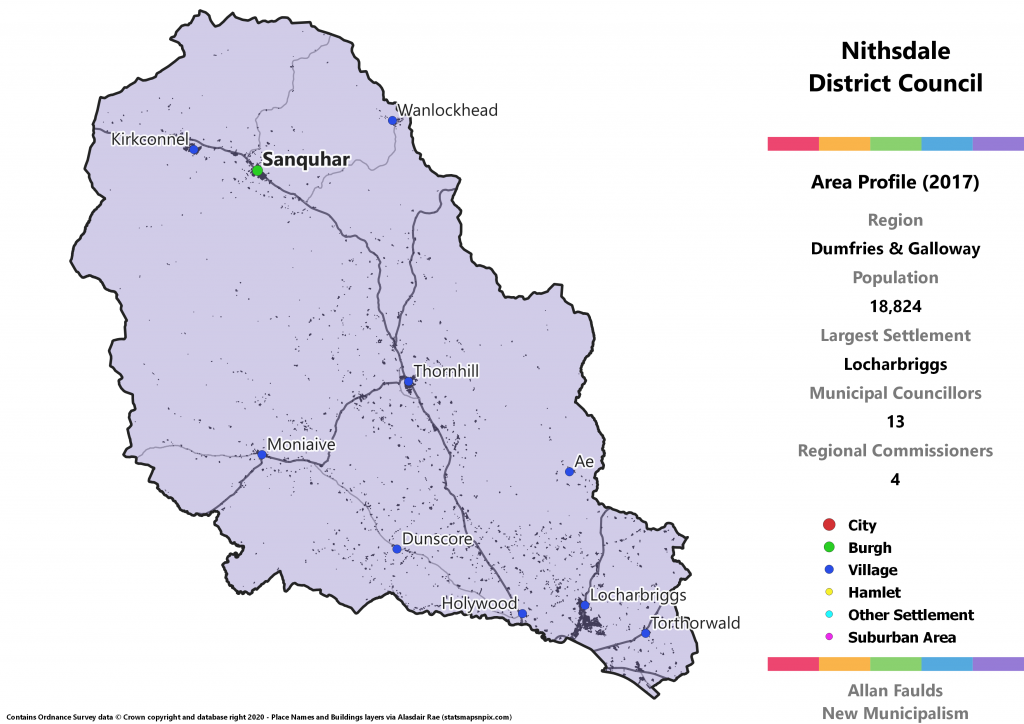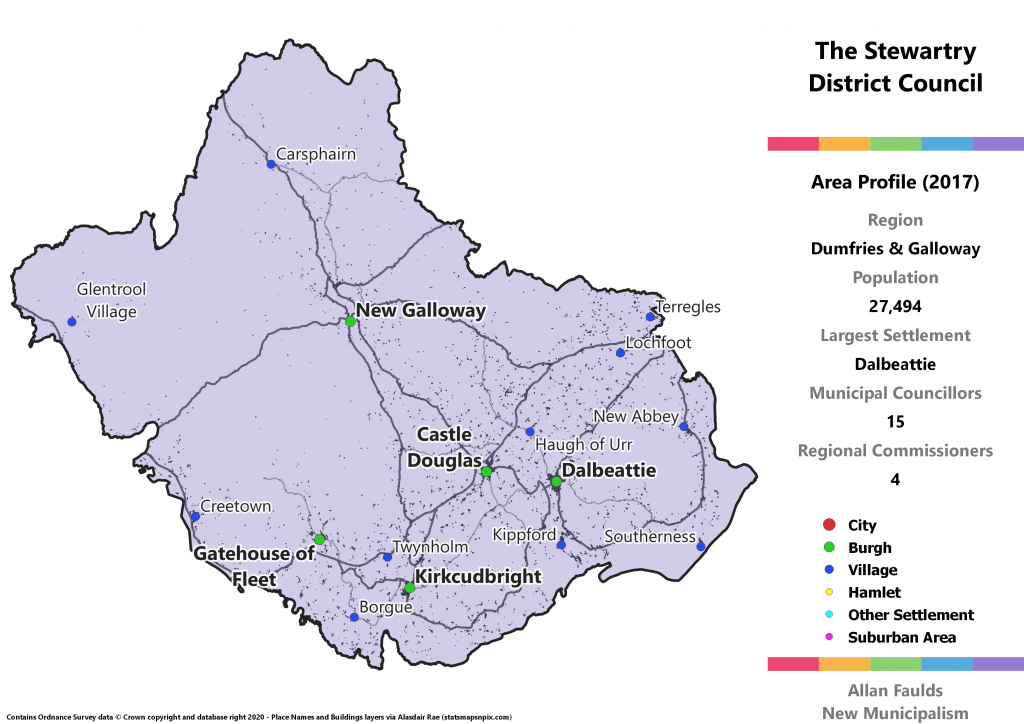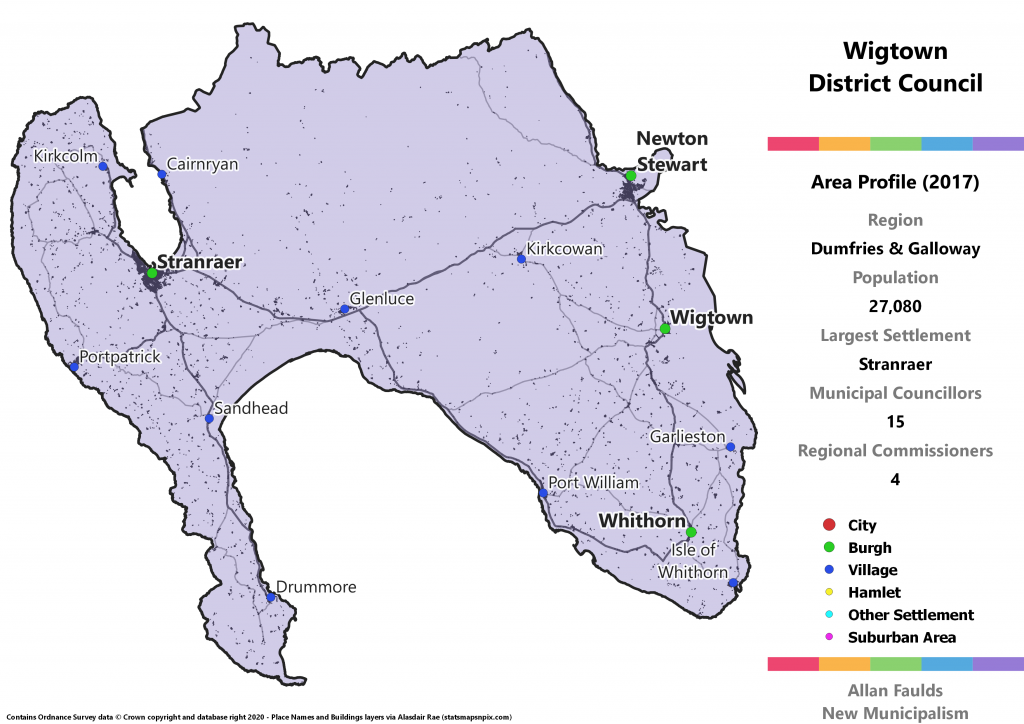Dumfries and Galloway Region Overview
Key Statistics
Municipalities: 5
Population: 149,200
Largest Settlement: Dumfries
Municipal Councillors: 83
Regional Commissioners: 23
Region Description
By far the smallest region by population, Dumfries and Galloway simply doesn’t tie neatly in with anywhere else. It’s a big rural area that’s already combining three distinct historic counties. It doesn’t have very good transport links to the Borders to the east, whilst Ayrshire to the west has a large population and a distinct identity of its own. D&G was it’s own region under the 1973 Act as well. I’m therefore quite comfortable leaving it as its own place.
That this massive area is a single Council under the current arrangements is a total nonsense. It’s patently absurd to have Gretna, which borders England, in the same most local unit of governance as Cairnryan, where the Northern Ireland ferries dock. It isn’t just the widely spread rural nature of the region that means it shouldn’t be a single unit – Dumfries is one of Scotland’s largest towns, with a very different set of local issues to the countryside surrounding it.
This isn’t an exact recreation of the 1973 Act region and its districts though. The historic boundaries of the three shires that make up the region – Wigtown, Kirkcudbright, Dumfries – are mostly restored, having been substantially disrupted in that previous two-tier system. There’s also an additional municipality, as I break Dumfries off from its shire to stand alone.
The Conservatives are the strongest party across the region, to the extent that they are only estimated to be one seat away from a majority on the Regional Council extrapolating from 2017 results. The split between SNP and Labour is reasonably close as well, with the latter retaining a certain level of historic strength here, whilst the former haven’t been able to reach the levels of support they have elsewhere in the country.
Annandale District
Area Profile (2017)
Population: 40,752
Largest Settlement: Annan
Municipal Councillors: 21
Regional Commissioners: 6
Municipality Description
One of three municipalities I’ve carved out of Dumfriesshire, Annandale is home to a rather large population for a rural district. There isn’t any sensible or neat way to split it, so I’ve just kept the whole area as one. It’s slightly expanded versus the 1973 district, primarily with the area to the southeast of Dumfries.
In hindsight I should also have revived the full title of that old district, “Annandale and Eskdale”, as it more accurately describes the area. The western portion from Moffat down to Annan is what is strictly speaking Annandale, as those villages all lie on or near the River Annan. From Eskdalemuir through Langholm to Canonbie is the less populous Eskdale, which obviously therefore follows the course of the River Esk.
Politically, Annandale is notable as the only part of the region which would elect Lib Dem councillors if extrapolating 2017 results. That shouldn’t be a surprise given the current Annandale South ward elected D&G’s only Lib Dem at that election.
Dumfries Burgh
Area Profile (2017)
Population: 35,050
Largest Settlement: Dumfries
Municipal Councillors: 19
Regional Commissioners: 5
Municipality Description
Dumfries is the main break with the 1973 Act version of a Dumfries and Galloway Region, in this project it’s more than due its own Burgh Council, as it had before that act. Compared to the historic Burgh, this version is a little larger. Most of that is simply to account for the expansion of the town, but I’ve also expanded it to take in the neighbouring village of Cargenbridge since it’s so close by.
I didn’t give it that title here, but I happen to reckon Dumfries is the most logical candidate to be officially declared Scotland’s 8th city. It’s only very slightly smaller than the 7th city, Stirling, and is by far and away the largest town for quite some distance, and could fairly claim to be the capital of the South of Scotland. Although other towns like Paisley, Kilmarnock, Livingston and Kirkcaldy are larger, they are all either clear satellites of existing cities or have neighbouring towns of roughly equal size and import.
As befits the only Burgh in D&G, Dumfries would also be home to the smallest (relative to the overall council size) Conservative group in the region based on 2017 results. They’d still be the largest party though.
Nithsdale District
Area Profile (2017)
Population: 18,824
Largest Settlement: Locharbriggs
Municipal Councillors: 13
Regional Commissioners: 4
Municipality Description
As a consequence of chopping Dumfries off into its own Burgh, the rump Nithsdale district ends up short of the 20,000 population target. This is a case where a rural waiver felt appropriate, so I went with it anyway. Apart from Dumfries, it also loses the Abbey area compared to the 1973 Act’s district of the same name, though that’s because I’ve re-asserted the Stewartry’s historic borders.
That does leave Nithsdale very slightly awkward as it effectively then consists of three lines of settlement converging on Dumfries, but not really meeting one another within the district. The main one follows the train line through Kirkconnel, Sanquhar and Thonhill. A secondary one mostly follows the Cairn Water from Monaive. The final one is centred on Locharbriggs, which is only just outside Dumfries. That’s just the hand geography has dealt it though.
Although as with the rest of the region the Conservatives would be in the lead here, Nithsdale’s status as a remaining holdout of strength for the Labour party is still in evidence. Extrapolating the 2017 results into this district shows a very rare SNP 3rd place.
The Stewartry District
Area Profile (2017)
Population: 27,494
Largest Settlement: Dalbeattie
Municipal Councillors: 15
Regional Commissioners: 4
Municipality Description
Forming the eastern half of Galloway, this area’s full title is the Stewartry of Kirkcudbright, or sometimes Kirkcudbrightshire to follow typical Scottish naming conventions. I opted to call the district The Stewartry just because it sounds quite cool, and it’d be well recognised locally. No point in having a uniquely interesting name if it isn’t used! Since the historic county more than crosses the population threshold, it’s very easy to justify sort of recreating it.
As with many counties, Kirkcudbright itself has been overtaken in size by some of its neighbours, though Dalbeattie and Castle Douglas aren’t that much bigger in the grand scheme of things. Whereas the 1973 Act district of the same name had been pinched at either end, this version mostly follows the traditional river-based boundaries of the Cree in the west and Nith in the east.
Wigtown District
Area Profile (2017)
Population: 27,080
Largest Settlement: Stranraer
Municipal Councillors: 15
Regional Commissioners: 4
Municipality Description
Historic Wigtownshire, the west and best end of Galloway, is re-created here as a district. In the 1973 Act it had pinched some land from the Stewartry by extending beyond the River Cree, but in this version only a very small area that allows the incorporation of the whole of Newton Stewart is taken. As with the other half of Galloway, given the population and historic county status, this is an obvious place to make into a municipality This area is basically two peninsulas connected by a thick isthmus.
The Rhins in the west includes both Stranraer, which is by now the major town of the county, and Scotland’s southernmost tip at the Mull of Galloway. The eastern peninsula is the Machars, where Wigtown itself is situated. It’s also home to Whithorn, which has historical importance as an early centre of Christianity, and the neighbouring Isle of Whithorn, which has personal importance as where one side of my family are from. At the risk of sounding like a travel agent, I’d recommend a weekend in the Machars to anyone as a lovely short break.
Based on 2017 results, Wigtown would have a Conservative majority. That’s quite poorly reflective of the actual vote shares, however, as the combined sum of Independent candidates won marginally more votes. The issue is that a couple of them won many more votes than were necessary to win their seat, whilst the remainder received quite low vote shares. Unfortunately, this is one of the prospective weaknesses of the proposed simple list electoral system, though in a real election under it voter behaviour may be quite different.
